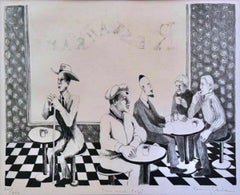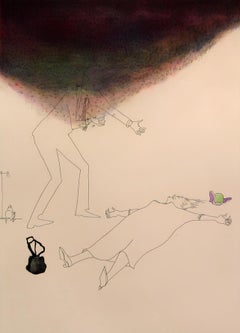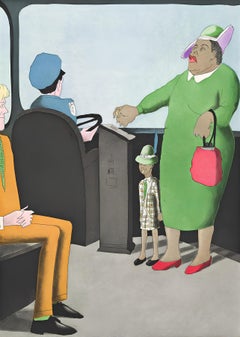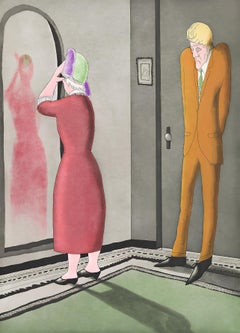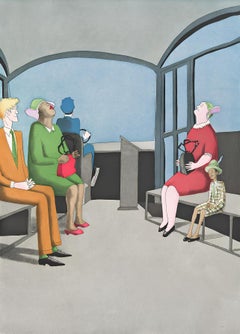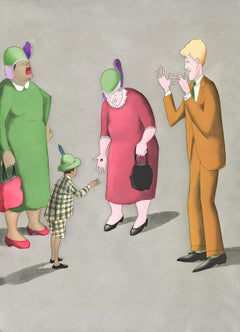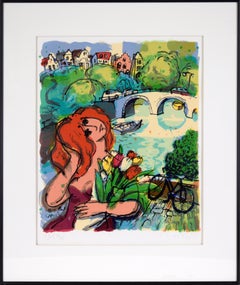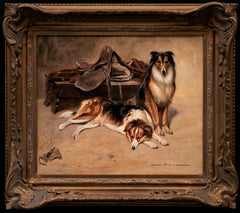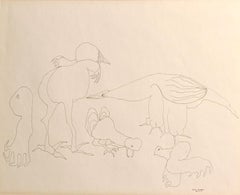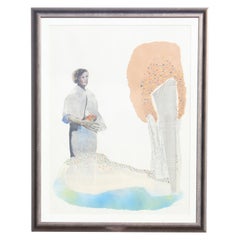Benny Andrews Art
Using an innovative technique he called “rough collage,” Benny Andrews created vivid portraits of everyday people that mixed painting with pieces of clothing and other textural materials.
Andrews grew up in a family of sharecroppers in rural Georgia, his creativity nurtured by his father, who was a self-taught artist, and his mother, who believed in the importance of education. He was the first in his family to complete high school and attended Fort Valley State College on a 4-H Club scholarship. Andrews was limited by the lack of art courses available to him at Fort Valley, and in 1950 he enlisted in the Air Force and served in the Korean War. On the G.I. Bill, he studied at the School of the Art Institute of Chicago (SAIC). While fellow students focused on Abstract Expressionism, Andrews developed his own expressive style; one of his earliest portraits was of the janitors at SAIC. After he graduated in 1958, he moved to New York. Andrews’s first solo show was in 1960 at Paul Kessler Gallery in Provincetown, Massachusetts.
Visibility and social justice were at the forefront of Benny Andrews’s paintings, which meditated on scenes of daily life, drawing on memories of the artist’s childhood in the South. His subjects included his family members as well as other artists, such as Alice Neel, Norman Lewis and Howardena Pindell.
A longtime educator, including for three decades at New York’s Queens College, Andrews avidly promoted opportunities for Black artists, such as cofounding with Clifford R. Joseph the Black Emergency Cultural Coalition in 1969, which advocated for inclusion in museum exhibitions. One of his final works —completed between 2004 and 2006 — was the Migrant Series in which he retraced the forced relocation of Indigenous people on the Trail of Tears, the Dust Bowl migration and the displacement of Hurricane Katrina survivors.
Andrews’s work has continued to garner acclaim after his death in 2006, with posthumous exhibitions including “Benny Andrews: Portraits, a Real Person Before the Eyes” at Michael Rosenfeld Gallery in New York in 2020.
Find Benny Andrews art on 1stDibs.
1960s Realist Benny Andrews Art
Paper, Lithograph
Early 2000s Expressionist Benny Andrews Art
Etching
Early 2000s Expressionist Benny Andrews Art
Etching
Early 2000s Expressionist Benny Andrews Art
Etching
Early 2000s Expressionist Benny Andrews Art
Etching
Early 2000s Expressionist Benny Andrews Art
Etching
1970s Contemporary Benny Andrews Art
Foil
Early 2000s Expressionist Benny Andrews Art
Etching
1980s Expressionist Benny Andrews Art
Lithograph
1980s Abstract Benny Andrews Art
Lithograph
1980s Expressionist Benny Andrews Art
Lithograph
1980s Expressionist Benny Andrews Art
Lithograph
1980s Expressionist Benny Andrews Art
Lithograph
1970s Contemporary Benny Andrews Art
Foil
1970s Contemporary Benny Andrews Art
Oil, Canvas
1990s Expressionist Benny Andrews Art
Ink, Archival Paper, Lithograph
Early 1900s Realist Benny Andrews Art
Canvas, Oil
Late 18th Century Old Masters Benny Andrews Art
Etching
2010s Realist Benny Andrews Art
Oil, Board, Paper, Mixed Media
2010s Realist Benny Andrews Art
Paper, Oil, Board
Late 20th Century Expressionist Benny Andrews Art
Lithograph
1980s Expressionist Benny Andrews Art
Paper, Ink, Lithograph
2010s Expressionist Benny Andrews Art
Paper, Coffee
1930s Expressionist Benny Andrews Art
Lithograph
Mid-19th Century Realist Benny Andrews Art
Paper, Oil
2010s Realist Benny Andrews Art
Paper, Oil, Board
Mid-20th Century Expressionist Benny Andrews Art
Aquatint, Color
1960s Modern Benny Andrews Art
Paper, Ink
1970s American Modern Benny Andrews Art
Mixed Media, Watercolor
1980s Expressionist Benny Andrews Art
Lithograph
1980s Expressionist Benny Andrews Art
Lithograph
1980s Expressionist Benny Andrews Art
Lithograph
1980s Expressionist Benny Andrews Art
Lithograph
Benny Andrews art for sale on 1stDibs.
Artists Similar to Benny Andrews
- 1stDibs ExpertApril 5, 2024To tell a print from an original painting, study its surface carefully. On a painting, you will likely notice variations in texture and see visible brushstrokes. Prints are more likely to appear smooth due to the printing process. However, some prints may be enhanced with hand-applied brushwork after the production process, which may make it more difficult to tell a painting from a print. When in doubt, seek the opinion of a certified appraiser or knowledgeable art dealer. Explore a wide range of fine art on 1stDibs.
- Where was Benny Andrews from?1 Answer1stDibs ExpertMarch 22, 2022Benny Andrews was from Plainview, Georgia. He received his formal artistic training at the School of the Art Institute of Chicago in Chicago, Illinois, and then moved to New York, New York, in 1958. Andrews died on November 10, 2006 in Brooklyn, New York. On 1stDibs, shop a collection of Benny Andrews art.
- 1stDibs ExpertJanuary 27, 2025The famous artist who drew squares was Piet Mondrian. He is best known for his geometric works that combine black lines with fill-in primary colors. Some of his most notable works include Composition with Red, Blue and Yellow; Broadway Boogie Woogie and New York City I. On 1stDibs, shop a collection of Piet Mondrian art.
